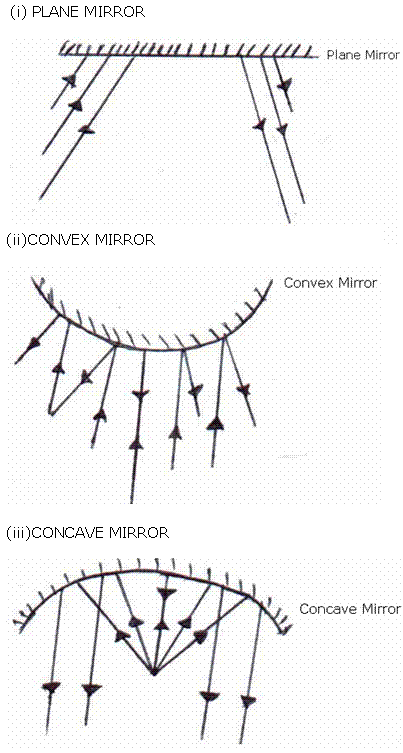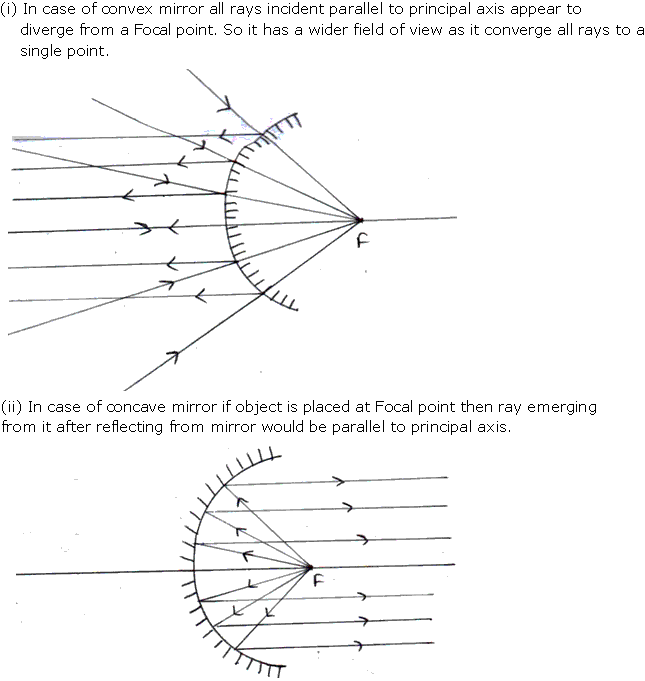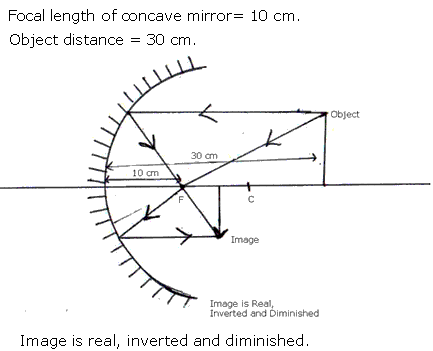Class 9 FRANK Solutions Physics Chapter 6: Light
At TopperLearning, get round the clock online access to the best Frank Solutions for ICSE Class 9 Physics Chapter 6 Light. Get in-depth knowledge of the properties of light through these model answers by experts. Learn about mirrors by revising your chapter lessons on focal length, linear magnification, principal axis and more.
You can further practise question from the ICSE Class 9 Physics syllabus through our sample question paper solutions and online practice tests. For doubts based on Chapter 6 concepts, check out our user-friendly ‘UnDoubt’ platform for response from experts.
261
262
263
264
Light Exercise 261
Solution 1
Convex mirror has a wider field of view.
Solution 2
Convex mirror always produces an erect image of the object.
Solution 3
Convex mirror is used in vehicles to see the traffic on rear side.
Solution 4
We will use convex mirror to see an enlarged image of our face.
Solution 5
Image of object placed at a long distance in front of a convex mirror is formed at principal focus. Radius of curvature of convex mirror is 20 cm.
Focal length of convex mirror = radius of curvature/2.
Focal length of convex mirror = 20/2 = 10 cm.
So image will form at principal focus 10 cm away from pole.
Focal length of convex mirror = radius of curvature/2.
Focal length of convex mirror = 20/2 = 10 cm.
So image will form at principal focus 10 cm away from pole.
Solution 6
Concave mirror can produce real and diminished image of the object.
Solution 7
The distance of the principal focus from the pole of the mirror is called the focal length of the mirror.
Solution 8
The mirror having +20 cm as its focal length is a convex mirror because focal length is taken positive only in case of convex mirror.
Solution 9
The focal length of plane mirror is infinity.
Solution 10
The mirror having -15 cm as its focal length is a concave mirror because focal length is taken negative only in case of concave mirror.
Solution 11
Principal axis is the straight line passing through the pole and the centre of curvature.
Solution 12
Linear magnification is defined as the ratio of the height of the image to the height of the object. It is taken to be positive for an image to be virtual and erect and negative when image is real and inverted.
Magnification = height of image / height of object.
Magnification = height of image / height of object.
Solution 13
Pole is the centre of the reflecting surface, in this case spherical mirror.
Solution 14
Centre of curvature is the centre of the imaginary sphere to which the mirror belongs.
Solution 15
Three characteristics of light are:-
(a). Light waves can travel through vacuum.
(b). Light waves are transverse waves.
(c). The velocity of light in vacuum is 3 x 108 m/s.
(a). Light waves can travel through vacuum.
(b). Light waves are transverse waves.
(c). The velocity of light in vacuum is 3 x 108 m/s.
Solution 16
Three distinctions between light and sound waves are
(i) Light waves can travel through vacuum while sound waves cannot.
(ii) Light waves are transverse waves while sound waves are longitudinal waves.
(iii) The velocity of light in air is 3 x 108 m/s while the speed of light in air is just about 330 m/s.
(i) Light waves can travel through vacuum while sound waves cannot.
(ii) Light waves are transverse waves while sound waves are longitudinal waves.
(iii) The velocity of light in air is 3 x 108 m/s while the speed of light in air is just about 330 m/s.
Solution 17
(i) When position of object is at infinity, concave mirror forms a point and Real image at Focus point.
(ii) When position of object is beyond C, concave mirror forms a Diminished, Real and inverted image between F and C.
(iii)When position of object is at C, concave mirror forms a Magnified, Real and inverted image at C.
(ii) When position of object is beyond C, concave mirror forms a Diminished, Real and inverted image between F and C.
(iii)When position of object is at C, concave mirror forms a Magnified, Real and inverted image at C.
Solution 18
Image formed by a convex mirror is always Diminished, Virtual and Erect.
Solution 19
Concave mirrors are used in reflecting microscope, in shaving and make up glasses and in ophthalmoscope.
Solution 20
(i) The distance from the pole in the direction of incident ray is taken positive.
(ii) The distance from the pole in the direction opposite to the incident ray is taken negative.
(ii) The distance from the pole in the direction opposite to the incident ray is taken negative.
Solution 21
Mirror formula is the relation between the focal length f of the mirror, the distance u of the object from the pole of the mirror, and the distance v of the image from the pole.
Mirror formula is
1/v +1/u = 1/f.
Linear magnification is defined as the ratio of the height of the image to the height of the object. It is taken to be positive for an image to be virtual and erect and negative when image is real and inverted.
Magnification = height of image / height of object.
Mirror formula is
1/v +1/u = 1/f.
Linear magnification is defined as the ratio of the height of the image to the height of the object. It is taken to be positive for an image to be virtual and erect and negative when image is real and inverted.
Magnification = height of image / height of object.
Solution 22
Mirror formula is the relation between the focal length f of the mirror, the distance u of the object from the pole of the mirror, and the distance v of the image from the pole.
Mirror formula is
1/v +1/u = 1/f.
Size of body = 1.5 m.
Magnification of body= 1.5.
Magnification = height of image / height of object.
Height of image = magnification
Mirror formula is
1/v +1/u = 1/f.
Size of body = 1.5 m.
Magnification of body= 1.5.
Magnification = height of image / height of object.
Height of image = magnification
Solution 23
Linear magnification is defined as the ratio of the height of the image to the height of the object. It is taken to be positive for an image to be virtual and erect and negative when image is real and inverted.
Magnification produced by concave mirror is:
Magnification = height of image / height of object.
It is a pure ratio and does not have any units.
Magnification produced by concave mirror is:
Magnification = height of image / height of object.
It is a pure ratio and does not have any units.
Solution 24

Solution 25
A smooth and polished surface causes regular reflection while a rough and unpolished surface causes irregular reflection.
Solution 26
When rays of light fall on a surface, they are turned back into the same medium in accordance with some definite laws. This process is known as reflection.
Reflection obeys following two laws
(a). The incident ray, the reflected ray, and the normal at the point of incidence, all lie in the same plane.
(b). The angle of incidence and the angle of reflection are always equal.
Reflection obeys following two laws
(a). The incident ray, the reflected ray, and the normal at the point of incidence, all lie in the same plane.
(b). The angle of incidence and the angle of reflection are always equal.
Solution 27
You can distinguish between plane mirror, a concave mirror, and a convex mirror without touching them. When you look into these mirrors by bringing your face close to each mirror, they will produce an image of your face of different types.
A plane mirror will produce an image of the same size as your face.
A concave mirror will produce a magnified image of your face.
A convex mirror will produce Diminished image of your face.
A plane mirror will produce an image of the same size as your face.
A concave mirror will produce a magnified image of your face.
A convex mirror will produce Diminished image of your face.
Solution 28
You can distinguish between a concave mirror and a convex mirror without touching them. When you look into these mirrors by bringing your face close to each mirror, they will produce an image of your face of different types.
A concave mirror will produce a magnified image of your face.
A convex mirror will produce Diminished image of your face.
A concave mirror will produce a magnified image of your face.
A convex mirror will produce Diminished image of your face.
Light Exercise 262
Solution 29

Solution 30
Uses of concave mirror:
(i) Concave mirrors are used in reflecting microscope
(ii) Concave mirrors are used in shaving and make up glasses.
Uses of convex mirror: Convex mirrors are used as a rear view mirror in automobiles as it provides a wider view of following traffic.
(i) Concave mirrors are used in reflecting microscope
(ii) Concave mirrors are used in shaving and make up glasses.
Uses of convex mirror: Convex mirrors are used as a rear view mirror in automobiles as it provides a wider view of following traffic.
Solution 31
We can see the reflection of our face on a polished table top because a regular reflection occurs in case of a polished surface while on a unpolished table top irregular reflection occurs which make image of our face unclear.
Solution 32
(i)The angle of incidence is the angle made by the incident ray with the plane mirror. {FALSE}
Correct statement is the angle of incidence is the angle made by the incident ray with the normal to the surface of plane mirror.
(ii) If a ray of light incident on a plane mirror is such that it makes an angle of 30o with the normal, then the angle of reflection is 60o.{FALSE}
Correct statement is if a ray of light incident on a plane mirror is such that it makes an angle of 30o with the normal, then the angle of reflection is 30o.
(iii)If the incident ray makes an angle of Xo with the normal, then the angle between the incident ray and reflected ray is 2Xo. {TRUE}
(iv)The image formed in a plane mirror is real, erect and same size as that of the object. {FALSE}
Correct statement is the image formed in a plane mirror is virtual, erect and same size as that of the object.
Correct statement is the angle of incidence is the angle made by the incident ray with the normal to the surface of plane mirror.
(ii) If a ray of light incident on a plane mirror is such that it makes an angle of 30o with the normal, then the angle of reflection is 60o.{FALSE}
Correct statement is if a ray of light incident on a plane mirror is such that it makes an angle of 30o with the normal, then the angle of reflection is 30o.
(iii)If the incident ray makes an angle of Xo with the normal, then the angle between the incident ray and reflected ray is 2Xo. {TRUE}
(iv)The image formed in a plane mirror is real, erect and same size as that of the object. {FALSE}
Correct statement is the image formed in a plane mirror is virtual, erect and same size as that of the object.
Solution 33

Solution 34

Solution 35
The image formed by a plane mirror is erect and virtual. It is a laterally inverted image. The image formed is of the same size as that of the object. Also, the image and the object are equidistant from the mirror.
Solution 36

Solution 37
Given, distance of boy from the mirror = 3 m
(a) Distance of image from mirror = distance of boy from the mirror = 3 m
Distance between boy and his image = distance of boy from the mirror + distance of image from mirror = 3+3 = 6 m
(b) Now, distance of boy from the mirror = 4 m
Distance of image from mirror = 4 m
Distance between boy and his image = distance of boy from the mirror + distance of image from mirror = 4+4 = 8m.
(a) Distance of image from mirror = distance of boy from the mirror = 3 m
Distance between boy and his image = distance of boy from the mirror + distance of image from mirror = 3+3 = 6 m
(b) Now, distance of boy from the mirror = 4 m
Distance of image from mirror = 4 m
Distance between boy and his image = distance of boy from the mirror + distance of image from mirror = 4+4 = 8m.
Solution 38
Periscope is used to see over the top of an obstacle. It is also used in submarines for observing for movement of ships. It can be used from the trenches for observing the movement on the surface of earth.
Light Exercise 263
Solution 39

Solution 40
(a) Pole is the centre of the reflecting surface, in this case spherical mirror.
(b) Centre of curvature is the centre of the imaginary sphere to which the mirror belongs
(c) Principal focus of a spherical mirror is a point on the principal axis of the mirror, where all the rays travelling parallel to the principal axis and close to it after reflection from the mirror, converge to or appear to diverge from.
(d) Principal axis is the straight line passing through the pole and the centre of curvature.
(e) Focus of a concave mirror is a point on the principal axis of the mirror, where all the rays travelling parallel to the principal axis and close to it after reflection from the mirror converge to that point.
(f) Normal to the surface of a mirror at any point is the straight line at right angle to the tangent drawn at that point.
(b) Centre of curvature is the centre of the imaginary sphere to which the mirror belongs
(c) Principal focus of a spherical mirror is a point on the principal axis of the mirror, where all the rays travelling parallel to the principal axis and close to it after reflection from the mirror, converge to or appear to diverge from.
(d) Principal axis is the straight line passing through the pole and the centre of curvature.
(e) Focus of a concave mirror is a point on the principal axis of the mirror, where all the rays travelling parallel to the principal axis and close to it after reflection from the mirror converge to that point.
(f) Normal to the surface of a mirror at any point is the straight line at right angle to the tangent drawn at that point.
Solution 41

Solution 42

Solution 43

Solution 44

Solution 45

Solution 46

Light Exercise 264
Solution 47

Solution 48

Solution 49

Solution 50

